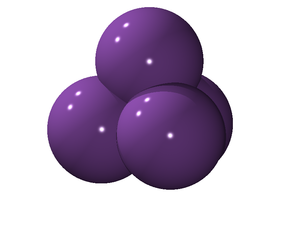Tetrahedral hard sphere model: Difference between revisions
Jump to navigation
Jump to search
Carl McBride (talk | contribs) m (New page: {{stub-general}} thumb|right The '''tetrahedral hard sphere model''' consists of four hard spheres located on the vertices of a [[Hard ...) |
Carl McBride (talk | contribs) (Removed stub and added numeric templates) |
||
| (One intermediate revision by the same user not shown) | |||
| Line 1: | Line 1: | ||
[[Image:HS_tetrahedron.png|thumb|right]] | [[Image:HS_tetrahedron.png|thumb|right]] | ||
The '''tetrahedral hard sphere model''' consists of four [[hard sphere model | hard spheres]] located on the vertices of a [[Hard tetrahedron model | regular tetrahedron]]. | The '''tetrahedral hard sphere model''' consists of four [[hard sphere model | hard spheres]] located on the vertices of a [[Hard tetrahedron model | regular tetrahedron]]. | ||
==Second virial coefficient== | |||
The [[second virial coefficient]] is given by (<ref name="AbascalBresme" >[http://dx.doi.org/10.1080/00268979200102181 J. L. F. Abascal and F. Bresme "Monte Carlo simulation of the equation of state of hard tetrahedral molecules", Molecular Physics '''76''' pp. 1411-1421 (1992)]</ref> Eq.5): | |||
:<math>\frac{B_2^*}{4V_m^*} = 1 + \frac{UL^* + VL^{*3}}{4}</math> | |||
where <math>L^*</math> is the reduced elongation, <math>V_m^*</math> is the corresponding reduced volume, <math>U=0.72477</math> and <math>V=4.730</math>. | |||
==Equation of state== | ==Equation of state== | ||
<ref> | The [[Equations of state | equation of state]] is given by (<ref name="AbascalBresme"> </ref> Eq. 17): | ||
:<math>\frac{\beta P}{\rho} = \frac{1+(1+UL^* + VL^{*3})y + (1+WL^* + XL^{*4})y^2 - (1+ ZL^{*3})y^3}{(1-y)^3}</math> | |||
where <math>U=0.72477</math>, <math>V=4.730</math>, <math>W=1.3926</math>, <math>X=24.78</math> and <math>Z=7.69</math>. | |||
==References== | ==References== | ||
<references/> | <references/> | ||
{{Numeric}} | |||
[[category: models]] | [[category: models]] | ||
Latest revision as of 15:05, 12 May 2010

The tetrahedral hard sphere model consists of four hard spheres located on the vertices of a regular tetrahedron.
Second virial coefficient[edit]
The second virial coefficient is given by ([1] Eq.5):
where is the reduced elongation, is the corresponding reduced volume, and .
Equation of state[edit]
The equation of state is given by ([1] Eq. 17):
where , , , and .








